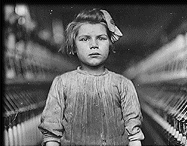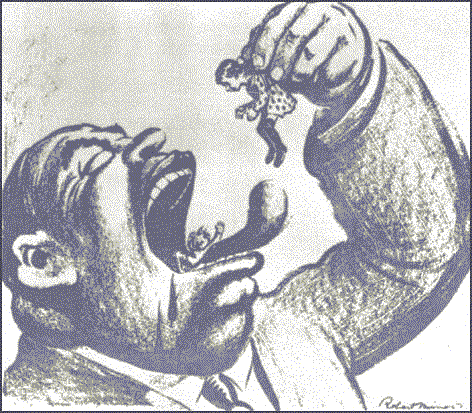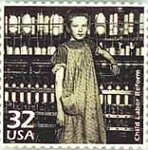Child Labor

Child Labor |
|
|
|
The rise of child labor in the United States began in the late 1700s and early 1800s. When the Industrial Revolution started, many families had to find someone to work or they wouldn't survive. When European immigrants came they weren't strangers to hard work. When they came they brought opinions or values that said that children should work. That's when children really started working. Many families moved from rural areas to cities newly industrialized. When it all started it went widespread and no one became concerned when the children didn't even get a modest education. By 1900, 2 million children were working so that their families could survive. |
|
Immigration only made the child labor problem worse. In the late 1800s there were 1,600 laws for child labor in the United States all together. These laws regulated working conditions and limited or forbidded child labor. These laws did not apply to any immigrant because they were thought not as American citizens but as low, poor people who didn't belong. |
|
Children worked at many jobs, anything that gave them an income to give to their family. The most popular and known are factories and mines. Other jobs are working in fields picking cotton and in the streets. Working in the street jobs included shining shoes, selling newspapers, canning fish, making clothes and weaving fabrics. |
|
With the knowledge that children worked in factories, mines, and other jobs lets talk about their wages and hours. A normal day for these abused children was anywhere from 12 to 19 hours a day. Most kids don't even go to school for 7 hours. An average day of work for adults is around 10 hours. These little children work 6 days a week, all year long. Kids today only go to school for 5 days. Then the extremely low wages were only a fraction of what adults got, if they got pay at all. They even tried to justify giving orphans nothing by saying that they provided clothing, shelter, and food. These "necessities" were never given to the orphans. All the time children were exhausted and hungry after these long hours.. |
|
| If the hours and the pay weren't bad enough the overseers would be especially cruel. Many children who were to small to reach the machines they were made textile assistants. These workers often abuse the children verbally and physically. When the children were late they had to walk up and down aisles in the factory for and hour with a heavy weight hanging on their neck. This punishment was said to make others "take example". They would usually end up with serious injuries to the neck and back. Sometimes boys were dragged out of bed and sent to work naked with their clothes to be put on at work so that they wouldn't be even a minute late. Since little children can't keep up with this pace they were constantly hit with straps and dipped head first into a cistern of water head first, so they wouldn't be drowsy on the job. Even orphans who were potential runaways were made to wear irons so they couldn't run. These tortures were very cruel and unusual bur most people know nothing about how their safety was neglected. |  |
|
Since no one cared about their safety, many children got hurt. One hospital said they had treated almost 1,000 children for wounds and mutilation from the big and dangerous machines they worked with, in just one year. And their employers would not even care even a little. Many were, "abandoned for the moment that an accident occurs, their wages are stopped, no medical attendance is provided, and whatever the extent of the injury, no compensation is offered." |
|
The factories and mines were polluted with many dust particles that would infect the lungs making it hard to breathe. They were described as "dirty, low-roofed, ill-ventilated, ill-drained; no conveniences for washing or dressing; no contrivance for carrying off dust and other effluvia." Many doctors would deal with children who were not breathing well. Dr. Charles Aston Key once said," impure air breathed for a great length of time must be productive of disease, or exceedingly weaken the body." |
|
You may think, why would their parents do this? Well many parents had to agree to it or their family wouldn't survive without the income. If they didn't work they didn't have enough income to live or have shelter. One man, Lewis Wickes Hines, quit teaching to go and take pictures of children working and expose the horrors of child labor to naive people. But still many thought child labor helped poor families and the community at large. Sometimes whole families were hired, men for the heavy work and women and children for the lighter work. |
|
School was rare for the children who worked. Many didn't get to go school, meaning they couldn't read or write making labor jobs their only jobs for the future. Some laws made it that the children have at least 2 hours of school each day. These laws were not followed very well. |
 |
|
Today |
|
Child labor is going on still today. The United States is included, but it isn't as big as other countries. This labor problem was mostly caused because of the Industrial Revolution. |
|
|
|
Today's Work Age Requirements for Non-Agricultural Jobs |
|
minimum age -14 except for these jobs
|
|
14-15: if school is in session- only 3 hours of work if school is out of session -only 8 hours of work
|
| 16-17: unlimited hours |
|
There have been people who made movements to stop child labor. In 1904, the National Child Labor committee was formed. In 1938, The Fair Labor Standards Act was passed, this made children free from work.
|
|
Fair Labor Standards Act
|
|
Some people even made posters and labeled them to help expose the truth. They said things like:
|
|
|
| Child Labor was and is a
horrible thing. We can only hope it won't come back and hurt our future
young ones like it has done for so many other countries.
|
| Bibliography |
| The History Place, Child Labor in America 1907-1912 Photographs of Lewis W. Hine, <http://www.historyplace.com/unitedstates/childlabor/about.htm>, 5-9-05 |
| Child Labors in Factories,< http://nhs.needham.k12.ma.us/cur/Baker_00/2002_p7/ak_p7/childlabor.html >, 5-11-05 |
| Spartacus Educational, Child Labor, < http://www.spartacus.schoolnet.co.uk/IRchild.htm >, 5-11-05 |
| Pittsburgh University of Pittsburgh Press, Child Labor, <http://www.pitt.edu/~press/goldentrianglebooks/childlabor.html#2>, 5-11-05 |
| Child Labor Coalition, Child Labor in the United States,< http://www.stopchildlabor.org/USchildlabor/fact1.htm>, 5-9-05 |
| Child Labor: An American Pictorial History,< http://www.awesomestories.com/history/child_labor/child_labor_ch1.htm> 5-9-05 |
| Pictures |
| Celebrate the Century, Child Labor,< http://www.usps.com/images/stamps/98/labor.jpg> 5-16-05 |
| The History Place, Child Labor in America 1907-1912 Photographs of Lewis W. Hine, <http://www.historyplace.com/unitedstates/childlabor/about.htm>, 5-16-05 |
| The History of the Crusade Against Child Labor, Child Labor Political Cartoons, <http://www.cpsd.us/kingopen/HumA/u.s.childlabor7.html> , 5-17-05 |
| Chelsea
Amack
8th Grade American History 2005 Project |